ATLAS-CONF-2017-030 09May2017
ATLAS CONF Note
ATLAS-CONF-2017-030
8th May 2017
Search for supersymmetry in final states with two same-sign or three leptons and jets using 36 fb √ − 1 of
s = 13 TeV p p collision data with the ATLAS detector
The ATLAS Collaboration
A search for strongly produced supersymmetric particles using signatures involving several energetic jets and either two isolated same-sign leptons (e or µ), or at least three isolated leptons, is presented. The analysis relies onb-tagged jets and missing transverse momentum, to achieve good sensitivity. A data sample of proton–proton collisions at
√s=13 TeV recor- ded with the ATLAS detector at the Large Hadron Collider in 2015 and 2016, corresponding to a total integrated luminosity of 36.1 fb−1, is used for the search. No significant excess over the Standard Model expectation is observed. The results are interpreted in several simplified supersymmetric models featuring R-parity conservation and R-parity violation, extending the exclusion limits from previous searches. In models considering gluino pair production, gluino masses are excluded up to 1.85 TeV at 95% confidence level. When bottom squarks are pair-produced and decay totχ˜±
1, models with bottom squark masses below 700 GeV and light neutralinos are excluded at 95% confidence level. In addition, model independent limits are set on a possible contribution of new phenomena to the signal region yields.
© 2017 CERN for the benefit of the ATLAS Collaboration.
Reproduction of this article or parts of it is allowed as specified in the CC-BY-4.0 license.
1 Introduction
Supersymmetry (SUSY) [1–6] is one of the most popular extensions of the Standard Model (SM). A general review can be found in Ref. [7]. In its minimal realisation (the MSSM) [8,9] it predicts a new bosonic (fermionic) partner for each fundamental SM fermion (boson), as well as an additional Higgs doublet. If R-parity [10] is conserved (RPC) the lightest supersymmetric particle (LSP) is stable and can be the lightest neutralino1 χ˜0
1. In many models, the LSP can be a dark matter candidate [11, 12]
and produce signatures with large missing transverse momentum. On the contrary, ifR-parity is violated (RPV), the LSP decay generates events with high jet and lepton multiplicity. Both RPC and RPV scenarios can produce the final state signature considered in this note.
In order to address the SM hierarchy problem with SUSY models [13–16], TeV-scale masses are re- quired [17,18] for the partners of the gluons (gluinos ˜g) and of the top quarks (top squarks ˜tL and ˜tR), due to the large top Yukawa coupling.2 The latter also favours significant ˜tL–˜tRmixing, so that the mass eigenstate ˜t
1 is lighter than all the other squarks in many scenarios [19, 20]. Bottom squarks ( ˜b) may also be light, being bound to top squarks bySU(2)Linvariance. This leads to potentially large production cross-sections for gluino pairs ( ˜gg˜), top–antitop squark pairs (˜t
1t˜∗
1) and bottom–antibottom squark pairs ( ˜b
1b˜∗
1) at the Large Hadron Collider (LHC) [21]. Production of isolated leptons may arise in the cascade decays of those superpartners to SM quarks and neutralinos ˜χ0
1, via intermediate neutralinos ˜χ0
2,3,4 or charginos ˜χ±
1,2that in turn lead toW, Z or Higgs bosons, or to lepton superpartners (sleptons, ˜l). Light third-generation squarks would also enhance gluino decays to top or bottom quarks over the generic decays involving light-flavour squarks, favouring the production of heavy flavour quarks and, in the case of top quarks, additional isolated leptons.
This note presents a search for SUSY in final states with two leptons (electrons or muons) of the same electric charge, referred to as same-sign (SS) leptons or three leptons (3L), jets and in some cases also missing transverse momentum, whose magnitude is referred to asEmiss
T . It is an extension of an earlier search performed by the ATLAS experiment [22] with
√s=13 TeV data [23], and uses the data collected in proton–proton (pp) collisions during 2015 and 2016. Similar searches for SUSY in this topology were also performed by the CMS experiment at
√s = 13 TeV [24–26]. While the same-sign or three lepton signatures are present in many scenarios of physics beyond the SM (BSM), SM processes leading to such final states have very small cross-sections. Compared to other BSM searches, analyses based on these signatures therefore allow the use of looser kinematic requirements (for example, onEmiss
T or on the momentum of jets and leptons), preserving sensitivity to scenarios with small mass differences between the produced gluinos/squarks and the LSP, or in whichR-parity is not conserved. This sensitivity to a wide range of BSM physics processes is illustrated by the interpretation of the results in the context of twelve different SUSY simplified models [27–29] that may lead to same-sign or three-lepton signatures.
For RPC models, the first four scenarios studied focus on gluino pair production with decays into on-shell (Fig.1(a)) or off-shell (Fig.1(b)) top quarks, as well as on-shell light quarks. The latter are accompanied by a cascade decay involving a ˜χ±
1 and a ˜χ0
2 (Fig. 1(c)) or a ˜χ0
2 and light sleptons (Fig. 1(d)). The other two RPC scenarios target the direct production of third generation squark pairs with subsequent electroweakino-mediated decays (Fig. 1(e) and 1(f)). The former is characterized by final states with
1The SUSY partners of the Higgs and electroweak gauge bosons, the electroweakinos, mix to form the mass eigenstates known as charginos ( ˜χ±l,l=1,2 ordered by increasing mass) and neutralinos ( ˜χ0m,m=1, . . . ,4 ordered by increasing mass).
2The partners of the left-handed (right-handed) quarks are labelled ˜qL(R). In the case where there is significant L/R mixing (as is the case for third generation squarks) the mass eigenstates of these squarks are labelled ˜q1,2ordered by increasing mass.
˜ g
˜ g p p
˜ χ01
¯t t
˜ χ01
t
¯t
(a)
˜ g
˜ g p
p
˜ χ01 t ¯b
W−
˜ χ01
¯b W− t (b)
˜ g
˜ g
˜ χ±1 χ˜02
˜ χ±1 χ˜02 p
p
q q¯0 W± Z
˜ χ01
¯ q0
q W±
Z
˜ χ01
(c)
˜ g
˜ g
˜ χ02 `˜∓/˜ν
˜ χ02 `˜∓/˜ν p
p
q q¯ `±/ν
`∓/ν
˜ χ01
¯
q q `±/ν
`∓/ν
˜ χ01
(d)
˜b1
˜b∗1
˜ χ−1
˜ χ+1 p
p
t
˜ χ01 W−
¯t
˜ χ01 W+
(e)
˜t1
˜t∗1
˜ χ02 χ˜±1
˜ χ02 χ˜±1
p p
t W∓ (W∗)
˜ χ01
¯t W∓
(W∗)
˜ χ01
(f)
˜ g
˜ g
˜t∗
˜t∗ p
p
t
λ00313 d b
t d b
(g)
˜ g
˜ g
˜t∗
˜t∗ p
p
t
λ00321 d s
t d s
(h)
˜ g
˜ g
˜ χ01
˜ χ01 p
p
q q¯
λ0
e/µ/ν q0
¯ q00
q q¯ e/µ/ν q0
¯ q00
(i)
˜ g
˜ g
˜ χ01
˜ χ01 p
p
t ¯t
λ00112 u
d s
t ¯t u
d s
(j)
˜ g
d˜R
d˜R
p p
λ00313 ¯t
¯b
¯t
¯b (k)
˜ g
d˜R
d˜R
p p
λ00321 ¯t
¯ s
¯t
¯ s
(l) Figure 1: RPC SUSY processes featuring gluino ((a), (b), (c), (d)) or third generation squark ((e), (f)) pair production studied in this analysis. RPV SUSY models considered are gluino pair production ((g), (h), (i), (j)) and t-channel production of down squark-rights ((k), (l)) which decay via baryon or lepton number violating couplingsλ00and λ0 respectively. In the diagrams,q =u,d,c,s and` =e, µ, τ. In Figure1(d), ˜l = e˜,µ,˜ τ˜and ˜ν =ν˜e,ν˜µ,ν˜τ. In Figure1(f),(W∗)indicates thatW-boson is off-shell – the mass difference between ˜χ±
1 and ˜χ0
1is around 1 GeV.
bottom squark pairs decaying tot¯tW Wχ˜0
1χ˜0
1. The latter, addressed here by looking for a three same-sign lepton final state, is a model that could explain the excess seen in same-sign lepton signatures during Run 1 [30]. Finally, a full SUSY model with low fine-tuning, the non-universal Higgs model with two extra parameters (NUHM2) [31,32], is also considered. When the soft SUSY breaking electroweakino mass,m1/2, is in the range 300–800 GeV, the model predominantly involves gluino pair production with gluinos decaying predominantely tot¯tχ˜0
1andtbχ˜±
1, giving rise to final states with two same-sign leptons andEmiss
T .
In the case of non-zero RPV couplings in the baryonic sector (λi jk00 ), as proposed in minimal flavour violation scenarios [33–35], gluinos and squarks may decay directly to top quarks, leading to final states with same-sign leptons [36,37] andb-quarks (Figs.1(g)and1(h)). Although these figures illustrate decay modes mediated by non-zeroλ00
313(resp. λ00
321) couplings, the exclusion limits set for these scenarios also hold for non-zeroλ00
323(resp. λ00
311orλ00
322), as these couplings lead to experimentally undistinguishable final states. Alternatively a gluino decaying to a neutralino LSP, that further decays to SM particles via a non-zero RPV coupling in the leptonic sector,λ0, orλ00, is also possible (Figs.1(i)and1(j)). LowerEmiss
T
is expected in these scenarios, as there is no stable LSP, and theEmiss
T originates from neutrinos produced in the ˜χ0
1and top-quark decays. Pair-production of3same-sign down squark-rights (Figs.1(k)and1(l)) is also considered. In all of these scenarios, anti-squarks decay into the charge-conjugate final states of thoset indicated for the corresponding squarks, and gluinos decay with equal probabilities into the given final state or its charge conjugate.
2 ATLAS detector
The ATLAS experiment [22] is a multi-purpose particle detector with a forward-backward symmetric cylindrical geometry and nearly 4πcoverage in solid angle.4 The interaction point is surrounded by an inner detector (ID), a calorimeter system, and a muon spectrometer (MS). The ID provides precision tracking of charged particles with pseudorapidities |η| < 2.5 and is surrounded by a superconducting solenoid providing a 2 T axial magnetic field. It consists of pixel and silicon-microstrip detectors inside a transition radiation tracker. One significant upgrade for the
√s =13 TeV running period is the presence of the Insertable B-Layer [38], an additional pixel layer close to the interaction point, which provides high- resolution hits at small radius to improve the tracking and vertexing performance. In the pseudorapidity region|η| < 2.5, high-granularity lead/liquid-argon electromagnetic sampling calorimeters are used. A steel/scintillator tile calorimeter measures hadron energies for|η| <1.7. The endcap and forward regions, spanning 1.5 < |η| < 4.9, are instrumented with liquid-argon calorimeters for both the electromagnetic and hadronic measurements. The MS consists of three large superconducting toroids with eight coils each, a system of trigger and precision-tracking chambers, which provide triggering and tracking capabilities in the ranges|η| <2.4 and |η| <2.7, respectively. A two-level trigger system is used to select events [39].
The first-level trigger is implemented in hardware. This is followed by the software-based high-level trigger stage, which can run offline-like reconstruction, reducing the event rate to about 1 kHz.
3 Dataset and simulated event samples
The data used in this analysis were collected during 2015 and 2016 with a peak instantaneous luminosity of L = 1.4× 1034 cm−2s−1. The mean number of pp interactions per bunch crossing (pile-up) in the dataset is 24. After the application of beam, detector and data quality requirements, the integrated luminosity considered corresponds to 36.1 fb−1. The uncertainty on the combined 2015+2016 integrated luminosity is 3.2%. It is derived, following a methodology similar to that detailed in Ref. [40], from a preliminary calibration of the luminosity scale usingx-y beam-separation scans performed in August 2015 and May 2016.
Monte Carlo (MC) simulated event samples are used to model the SUSY signals and to estimate the irreducible SM background with two same-sign and/or three “prompt” leptons (originating from on-shell
3These RPV baryon-number-violating couplings only apply toSU(2)singlets.
4ATLAS uses a right-handed coordinate system with its origin at the nominal interaction point (IP) in the centre of the detector and the z-axis along the beam pipe. The x-axis points from the IP to the centre of the LHC ring, and the y- axis points upward. Cylindrical coordinates (r, φ) are used in the transverse plane, φbeing the azimuthal angle around the beam pipe. The pseudorapidity is defined in terms of the polar angleθasη = −ln tan(θ/2). Rapidity is defined as y = 0.5 ln(E+pz)/(E−pz)
where E denotes the energy andpz is the component of the momentum along the beam direction. The transverse momentumpT, the transverse energyETand the missing transverse momentumEmiss
T are defined in thex−yplane.
heavy boson decays). The reducible background, mainly arising fromt¯t production, is estimated from the data as described in Section5.1. The MC samples are processed through a detailed ATLAS detector simulation [41] based on Geant4 [42] or a fast simulation using a parameterization of the calorimeter response and Geant4 for the ID and MS [43]. To simulate the effects of additional ppcollisions in the same and nearby bunch crossings, inelastic interactions are generated using the soft strong interaction processes of Pythia 8.186 [44] with the A2 tune [45] and the MSTW2008LO parton distribution function (PDF) [46]. These MC events are overlaid onto the simulated hard scatter event and reweighted to match the pile-up conditions observed in the data. The event generator, parton shower, cross-section normalization, PDF set and underlying-event tune of all samples are presented in Table1. In all MC samples, except those produced by the Sherpa generator, the EvtGen v1.2.0 program [47] is used to model the properties of bottom and charm hadron decays.
Physics process Event generator Parton shower Cross-section PDF set Tune
normalization Signal
RPC MG5_aMC@NLO 2.2.3 [48] Pythia 8.186 [44] NLO+NLL NNPDF2.3LO [49] A14 [50]
RPV except Fig.1(j) MG5_aMC@NLO 2.2.3 Pythia 8.210 or NNPDF2.3LO A14
RPV Fig.1(j) Herwig 2.7.1 [51] Herwig 2.7.1 NLO-Prospino2 [52–57] CTEQ6L1 [58] UEEE5 [59]
tt¯+X
ttW,¯ t¯t Z/γ∗ MG5_aMC@NLO 2.2.2 Pythia 8.186 NLO [60] NNPDF2.3LO A14
tt H¯ MG5_aMC@NLO 2.3.2 Pythia 8.186 NLO [60] NNPDF2.3LO A14
ttt¯t¯(4t) MG5_aMC@NLO 2.2.2 Pythia 8.186 NLO [48] NNPDF2.3LO A14
Diboson
Z Z,W Z Sherpa 2.2.1 [61] Sherpa 2.2.1 NLO [62] NNPDF2.3LO Sherpa default Other (inc.W±W±) Sherpa 2.1.1 Sherpa 2.1.1 NLO [62] CT10 [63] Sherpa default Rare
ttW W¯ ,ttW Z¯ MG5_aMC@NLO 2.2.2 Pythia 8.186 NLO [48] NNPDF2.3LO A14
t Z,tW Z,ttt¯ MG5_aMC@NLO 2.2.2 Pythia 8.186 LO NNPDF2.3LO A14
W H,Z H MG5_aMC@NLO 2.2.2 Pythia 8.186 NLO [64] NNPDF2.3LO A14
Triboson Sherpa 2.1.1 Sherpa 2.1.1 NLO [62] CT10 Sherpa default
Table 1: Simulated signal and background event samples: the corresponding event generator, parton shower, cross- section normalization, PDF set and underlying-event tune is shown for each sample. Because of their very small contribution to the signal region background estimatettW W¯ , t¯tW Z, t Z, tW Z,ttt¯, W H, Z H and triboson are summed and labelled “Rare” in the following. NLO-Prospino2 refers to RPV down squark models of Fig.1(k)and 1(l), as well as the NUHM2 model.
The SUSY signals from Figure1are defined by an effective Lagrangian describing the interactions of a small number of new particles [27–29]. All SUSY particles not included in the decay of the pair-produced squarks and gluinos are effectively decoupled. These simplified models assume one production process and one decay channel with a 100% branching fraction. They are generated from leading order (LO) matrix elements with up to two extra partons in the matrix element (only up to one for the ˜g → qq(``/νν¯ )χ˜0
1
model) using MG5_aMC@NLO 2.2.3 [48] interfaced to Pythia 8.186 with the A14 tune [50] for the modelling of the parton shower, hadronization and underlying event. Jet–parton matching is realised following the CKKW-L prescription [65], with a matching scale set to one quarter of the pair-produced superpartner mass. All signal models are generated with prompt decays of the SUSY particles. Signal cross-sections are calculated at next-to-leading order (NLO) in the strong coupling constant, adding the resummation of soft-gluon emission at next-to-leading-logarithmic accuracy (NLO+NLL) [52–56], except for the RPV models of Fig.1(k) and Fig.1(l)and the NUHM2 model where NLO cross-sections are used [52,66]. The nominal cross-sections and the uncertainties are taken from envelopes of cross- section predictions using different PDF sets and factorisation and renormalization scales, as described in Refs. [21,57]. Typical pair production cross-sections are: 4.7±1.2 fb for gluinos with a mass of 1.7 TeV, 28.3±4.0 fb for bottom squarks with a mass of 800 GeV, and 15.0±2.0 fb for down squark rights with a
mass of 800 GeV and a gluino mass of 2.0 TeV.
The two dominant irreducible background processes aret¯tV (withV being a W or Z/γ∗ boson) and diboson production with four charged leptons`,5 three charged leptons and one neutrino, or two same- sign charged leptons and two neutrinos. The MC simulation samples for these are described in detail in Refs. [67] and [62], respectively. For diboson production, the matrix elements contain the doubly resonant diboson processes and all other diagrams with four or six electroweak vertices, such asW±W±j j, with one (W±W±j j) or two (W Z,Z Z) extra partons. NLO cross-sections fort¯tW,tt Z/γ¯ ∗(→``)6and leptonic diboson processes are respectively 600.8 fb [60], 123.7 fb and 6.0 pb [62]. The processestt H¯ andt¯ttt¯, with NLO cross-sections of 507.1 fb [60] and 9.2 fb [48] respectively, are also considered.
Other background processes with small cross-sections are grouped into a category labelled “Rare”.
This category containst¯tW W andttW Z¯ events generated with no extra parton in the matrix element, t Z, tW Z, ttt¯, W H and Z H as well as triboson (W W W, W W Z, W Z Z and Z Z Z) production with up to six charged leptons. The processes W W Z → 4`+2ν,2`+4ν, W W W,W Z Z → 3` +3ν and Z Z Z →6`+0ν,4`+2ν,2`+4νare generated at NLO with additional LO matrix elements for up to two extra partons.
4 Object reconstruction and selection
Candidate events are required to have a reconstructed vertex [69], with at least two associated tracks with pT >400 MeV. The vertex with the largestΣp2
Tof the associated tracks is chosen as the primary vertex of the event.
For the data-driven background estimations, two categories of electrons and muons are used: “candidate”
and “signal” with the latter being a subset of the “candidate” leptons satisfying tighter selection criteria.
Electron candidates are reconstructed from energy depositions in the electromagnetic calorimeter that have been matched to an ID track and are required to have |η| < 2.47, pT > 10 GeV, and to pass the
“Loose” likelihood-based identification requirement [70]. Candidates within the transition region between the barrel and endcap electromagnetic calorimeters, 1.37 < |η| < 1.52, are not considered. The track matched with the electron must have a significance of the transverse impact parameter with respect to the reconstructed primary vertex, d0, of |d0|/σ(d0) < 5. Muon candidates are reconstructed in the region |η| < 2.5 from muon spectrometer tracks matching ID tracks. All muon candidates must have pT >10 GeV and must pass the “Medium” identification requirements [71].
Jets are reconstructed with the anti-kt algorithm [72] with radius parameter R = 0.4, using three- dimensional topological energy clusters in the calorimeter [73] as input. All jets must havepT > 20 GeV and|η| < 2.8. For all jets the expected average energy contribution from pile-up is subtracted according to the jet area [74,75]. Jets are then calibrated as described in Ref. [75]. In order to reduce the effects of pile-up, jets withpT< 60 GeV and|η| <2.4 are required to have a significant fraction of their associated tracks originating from the primary vertex, as defined by the jet vertex tagger (JVT) [76].
Identification of jets containingb-hadrons (b-tagging) is performed with the MV2c10 algorithm, a mul- tivariate discriminant making use of track impact parameters and reconstructed secondary vertices [77, 78]. A requirement is chosen corresponding to a 70% average efficiency for taggingb-jets in simulatedt¯t
5All lepton flavours are included here andτleptons subsequently decayed leptonically or hadronically.
6This cross-section is computed using the configuration of Refs. [48,68].
events. The rejection factors for light-quark/gluon jets,c-quark jets and hadronically decayingτleptons in simulatedtt¯events are approximately 380, 12 and 54, respectively [78,79]. Jets with|η| <2.5 which satisfy theb-tagging and JVT requirements are identified as b-jets. Correction factors and uncertain- ties determined from data for the b-tagging efficiencies and mis-tag rates are applied to the simulated samples [78].
After the object identification, overlaps between the different objects are resolved. Any jet within a distance∆Ry = p
(∆y)2+(∆φ)2 =0.2 of a lepton candidate is discarded, unless the jet is b-tagged7, in which case the lepton is discarded since it is likely originating from a semileptonicb-hadron decay. Any remaining lepton within∆Ry =min{0.4,0.1+9.6 GeV/pT(`)}of a jet is discarded. In the case of muons, the muon is retained and the jet is discarded if the jet has fewer than three associated tracks. This recovers inefficiencies for high-energy muons undergoing significant energy loss in the calorimeter.
Signal electrons must satisfy the “Medium” likelihood-based identification requirement [70]. In regions with large amounts of material in the tracker, an electron (resp. positron) may more likely emit a hard bremsstrahlung photon. If the photon subsequently converts to an asymmetric electron–positron pair, and the the positron (resp. electron) is high momentum and reconstructed, the lepton charge can be mis-identified (later referred to as “charge-flip”). To reduce the impact of charge mis-identification, signal electrons must satisfy|η| <2.0. Furthermore, signal electrons that are likely to be reconstructed with an incorrect charge assignment are rejected using the following electron cluster and track properties including the impact parameter, the curvature significance, the cluster width, and the quality of the matching between the cluster and its associated track, both in terms of energy and position. These variables, as well as the electronpT andη, are combined into a single classifier using a boosted decision tree (BDT) algorithm.
A selection requirement on the BDT output is chosen to achieve a rejection factor between 7 and 8 for electrons with a wrong charge assignment while selecting correctly measured electrons with an efficiency of 97%. Correction factors to account for differences in the selection efficiency between data and MC simulation have been applied to the selected electrons in the MC simulation. These correction factors are determined usingZ →eeevents [80].
Signal muons must fulfil the requirement |d0|/σ(d0) < 3. Tracks associated with the signal electrons or muons must have a longitudinal impact parameter with respect to the reconstructed primary vertex, z0, satisfying |z0sinθ| < 0.5 mm. Isolation requirements are applied to both the signal electrons and muons. The scalar sum of thepT of tracks within a variable-size cone around the lepton, excluding its own track, must be less than 6% of the leptonpT. The track isolation cone radius for electrons (muons)
∆Rη =p
(∆η)2+(∆φ)2is given by the smaller of∆Rη =10 GeV/pTand∆Rη =0.2(0.3). In addition, in the case of electrons the calorimeter energy clusters in a cone of ∆Rη = 0.2 around the electron (excluding the deposit from the electron itself) must be less than 6% of the electronpT. Simulated events are corrected to account for differences in the lepton trigger, reconstruction, identification and isolation efficiencies between data and MC simulation.
The missing transverse momentum is defined as the negative vector sum of the transverse momenta of all identified candidate objects (electrons, photons [81], muons and jets) and an additional soft term. The soft term is constructed from all tracks that are not associated with any physics object, but are associated with the primary vertex. In this way, the Emiss
T is adjusted for the best calibration of the jets and the other identified physics objects above, while maintaining approximate pile-up independence in the soft term [82,83].
7In this case theb-tagging operating point corresponding to an efficiency of 85% is used.
Events are selected using a combination of dilepton andEmiss
T triggers, the latter being used only for events withEmiss
T >250 GeV. The trigger-level requirements onEmiss
T and the leading and subleading leptonpT are looser than those applied offline to ensure that trigger efficiencies are constant in the relevant phase space. The event selection requires at least two signal leptons withpT > 20 GeV (apart from two SRs where the subleading leptonpTshould be greater than 10 GeV8). If the event contains exactly two signal leptons, they must have the same electric charge. Events are discarded if they contain any jet failing basic quality selection criteria in order to reject detector noise and non-collision background events [84,85].
To maximize the sensitivity to the signal models of Figure 1, nineteen mutually non-exclusive signal regions are defined in Table2. The SRs are named in the formSNLMbX, where S indicates if the SR is targeting an RPC or RPV model,N indicates the number of leptons required,Mthe number ofb-jets required, andX indicates the severity of the Emiss
T ormeff requirements (Soft, Medium or Hard). The requirements used to define the SRs are the number of signal leptons (Nsignal
leptons), number of b-jets with pT >20 GeV (Nb-jets), number of jets withpT above 25, 40 or 50 GeV, regardless of their flavour (Njets), Emiss
T , the effective mass (meff) and the charge of the signal leptons. Themeff variable is defined as the scalar sum of the pT of the signal leptons, jets and the Emiss
T . For SRs where the Z+jets background is important (Rpc3LSS1b, Rpv2L0b and Rpv2L2bH), events with a two same-sign electron invariant mass close to theZ-boson mass are vetoed. For SRs targeting the production of down squark pairs (Rpv2L1bS, Rpv2L2bS, Rpv2L1bM), only events with at least two negatively-charged leptons are considered, as the down squarks decay exclusively to top anti-quarks. Finally, SRs targeting signal scenarios with leptonpT spectra softer than typical background processes impose an upper cut on the leptons’pT. The last column indicates the targeted signal model. The Rpc3L1b and Rpc3L1bH SRs are not motivated by a particular signal model and can be seen as a natural extension of the Rpc3L0b SRs with the same kinematic cuts but requiring at least oneb-jet.
The values of acceptance times efficiency of the SR selections for the RPC SUSY signal models, with masses near the exclusion limit, typically range between 0.5% and 7% for models with a light ˜χ0
1 and 0.5–2% for models with a heavy ˜χ0
1. For RPV SUSY signal models, these values are in the range 0.2–4%.
To increase the signal efficiency for the SUSY models with low energetic leptons (Figure1(b)and1(c)), thepTthreshold of leptons is relaxed from 20 to 10 GeV in the SR definition.
5 Background estimation
Two main sources of SM background can be distinguished in this analysis. The first category is the reducible background, which includes events containing electrons with mis-measured charge, mainly from the production of top-quark pairs, and events containing at least one fake or non-prompt (FNP) lepton. The FNP lepton mainly originates from heavy-flavour hadron decays in events containing top quarks,WorZbosons. Hadrons mis-identified as leptons, electrons from photon conversions and leptons from pion or kaon decays in flight are other possible sources. Data-driven methods used for the estimation of this reducible background in the signal and validation regions are described in Section5.1. The second category is the irreducible background from events with two same-sign prompt leptons or at least three prompt leptons and is estimated using the MC simulation samples. Since diboson andttV¯ events are the main backgrounds in the signal regions, dedicated validation regions (VR) with an enhanced contribution
8In order to ensure that the trigger efficiency is constant for selected events where the subleading leptonpTlies between 10 and 20 GeV theEmiss
T trigger is choosen.
Signal region Nsignal
leptons Nb-jets Njets pjet
T Emiss
T meff Emiss
T /meff Other Targeted
[GeV] [GeV] [GeV] Signal
Rpc2L2bS ≥2SS ≥2 ≥6 >25 >200 >600 >0.25 – Fig.1(a)
Rpc2L2bH ≥2SS ≥2 ≥6 >25 – >1800 >0.15 – Fig.1(a), NUHM2
Rpc2Lsoft1b ≥2SS ≥1 ≥6 >25 >100 – >0.3 20,10<p`T1,p`2
T<100 GeV Fig.1(b) Rpc2Lsoft2b ≥2SS ≥2 ≥6 >25 >200 >600 >0.25 20,10<p`T1,p`2
T<100 GeV Fig.1(b)
Rpc2L0bS ≥2SS =0 ≥6 >25 >150 – >0.25 – Fig.1(c)
Rpc2L0bH ≥2SS =0 ≥6 >40 >250 >900 – – Fig.1(c)
Rpc3L0bS ≥3 =0 ≥4 >40 >200 >600 – – Fig.1(d)
Rpc3L0bH ≥3 =0 ≥4 >40 >200 >1600 – – Fig.1(d)
Rpc3L1bS ≥3 ≥1 ≥4 >40 >200 >600 – – None
Rpc3L1bH ≥3 ≥1 ≥4 >40 >200 >1600 – – None
Rpc2L1bS ≥2SS ≥1 ≥6 >25 >150 >600 >0.25 – Fig.1(e)
Rpc2L1bH ≥2SS ≥1 ≥6 >25 >250 – >0.2 – Fig.1(e)
Rpc3LSS1b ≥`±`±`± ≥1 – – – – - veto 81<me±e±<101 GeV Fig.1(f)
Rpv2L1bH ≥2SS ≥1 ≥6 >50 – >2200 – – Figs.1(g),1(h)
Rpv2L0b =2SS =0 ≥6 >40 – >1800 – veto 81<me±e±<101 GeV Fig.1(i) Rpv2L2bH ≥2SS ≥2 ≥6 >40 – >2000 – veto 81<me±e±<101 GeV Fig.1(j)
Rpv2L2bS ≥`−`− ≥2 ≥3 >50 – >1200 – – Fig.1(k)
Rpv2L1bS ≥`−`− ≥1 ≥4 >50 – >1200 – – Fig.1(l)
Rpv2L1bM ≥`−`− ≥1 ≥4 >50 – >1800 – – Fig.1(l)
Table 2: Summary of the signal region definitions. Unless explicitely stated in the table, at least two signal leptons withpT>20 GeV and same charge (SS) are required in each signal region. Requirements are placed on the number of signal leptons (Nsignal
leptons), the number ofb-jets withpT>20 GeV (Nb-jets), the number of jets (Njets) above a certain pTthresholds (pjet
T),Emiss
T ,meffand/orEmiss
T /meff. The last column indicates the targeted signal model.
from these processes, and small signal contamination, are defined to verify the background predictions from the simulation (Section5.2). Section 5.3discusses the systematic uncertainties considered when performing the background estimation in the signal and validation regions.
5.1 Reducible background estimation methods
Charge mis-identification is only relevant for electrons. The contribution of charge-flip events to the SR/VR is estimated using the data. The electron charge-flip probability is extracted in aZ/γ∗→eedata sample using a likelihood fit which takes as input the numbers of same-sign and opposite-sign electron pairs observed in a window of 10 GeV around the Z boson mass. The charge-flip probability is a free parameter of the fit and is extracted as a function of the electronpTandη. These probabilities are around 0.5% (1%) and 0.1% (0.2%) for the candidate and signal electrons for|η| <1.37(|η| > 1.52), respectively.
The former is used only in the FNP lepton background estimation. The event yield of the charge-flip electron background in the signal or validation regions is obtained by multiplying the measured charge-flip probability with the number of events in data regions with the same kinematic requirements as the signal or validation regions but with opposite-sign lepton pairs.
Two data-driven methods are used to estimate the FNP lepton background, referred to as the “matrix method” and the “MC template method”. The estimates from these methods are combined to give the final estimate. These two methods are described below.
The first estimation of the FNP lepton background is performed with a matrix method similar to that described in Ref. [86]. Two types of lepton identification criteria are defined: “tight”, corresponding to
the signal lepton criteria described in Section4, and “loose”, corresponding to candidate leptons after object overlap removal and the charge-flip BDT selection described also in Section4. The matrix method relates the number of events containing prompt or FNP leptons to the number of observed events with tight or loose-not-tight leptons using the probability for loose prompt or FNP leptons to satisfy the tight criteria. The probability for loose prompt leptons to satisfy the tight selection criteria (ε) is obtained using aZ/γ∗→``data sample and is modelled as a function of the leptonpTandη. The efficiencies for electrons (muons) rise from 60% (80%) at lowpTto almost 100% atpTabove 50 GeV – apart from endcap electrons which reach only 95%. The probability for loose FNP leptons to satisfy the tight selection criteria (FNP lepton rate, f) is determined from data in SS control regions enriched in non-prompt leptons mostly originating from heavy-flavour hadron decays in single leptont¯tevents. This region contains events with at least one b-jet, one well-isolated muon (referred to as the “tag”), and an additional loose electron or muon which is used for the measurement. The rates fare measured as function ofpT9after subtracting the small contribution from prompt lepton processes predicted by simulation and the data-driven estimation of events with electron charge-flip. For electrons, and muons with|η| < 2.3, f is constant around 10%
forpT < 30 GeV and increases at higherpT. These values ofεand f correspond to a regime where the method has been demonstrated to correctly estimate the FNP lepton background.
The second method for FNP lepton estimation is the MC template method [86,87]. It relies on the correct modelling of the kinematic distributions of the FNP leptons and charge-flipped electron processes int¯t andV+jets samples. These samples are simulated with the Powheg-Box generator [88–91] and the parton shower and hadronization performed by either Pythia 6.428 [92] (tt¯) or Pythia 8.186 (V+jets). The FNP leptons are classified in five categories, namely electrons and muons coming fromband light-quark jets as well as photon conversions. Normalization factors for each of the five sources are adjusted to match the observed data in dedicated control regions. Events are selected with at least two same-sign signal leptons, Emiss
T > 40 GeV, two or more jets, and are required to be orthogonal to the SRs. They are further split into regions with or withoutb-jets and with different lepton flavours of the same-sign lepton pair, giving a total of six control regions. The global normalization factors applied to the MC samples estimating the reducible background in each SR varies from 1.2±1.1 to 2.9±2.0, where the errors account for statistical uncertainties and uncertainties related to the choice of the event generator (see Section5.3).
Since the FNP lepton predictions from the MC template and matrix methods in the signal and validation regions are consistent with each other, a weighted average of the two results is used. This approach implies that the combined estimate is dominated by systematic uncertainties, which is not always the case when the matrix method is used, due to limited statistics in the control regions. To check the validity and robustness of the FNP lepton estimate, the distributions of several discriminating variables in data are compared with the predicted background after various requirements on the number of jets andb-jets. Examples of such distributions are shown in Fig.2, and illustrate that the data are described by the prediction within uncertainties. The apparent disagreement for meff above 1 TeV in Figure 2(d) is covered by the large theory uncertainty for the diboson background, which is not shown on the Figure but amounts to about 30% formeffabove 1 TeV.
5.2 Validation of irreducible background estimates
Dedicated validation regions are defined to verify the estimate of thet¯tV,W ZandW±W±background in the signal regions. The corresponding selections are summarized in Table3. The overlap with the signal
9For muons withpT<20 GeV, f is parametrized as a function ofpTandη.
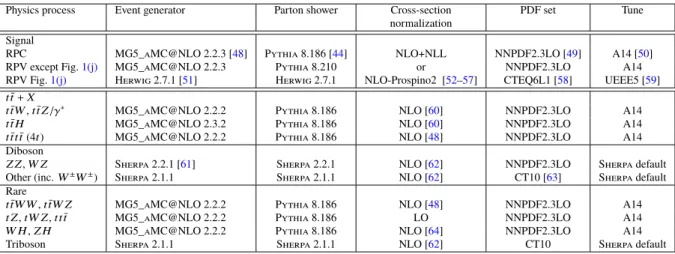
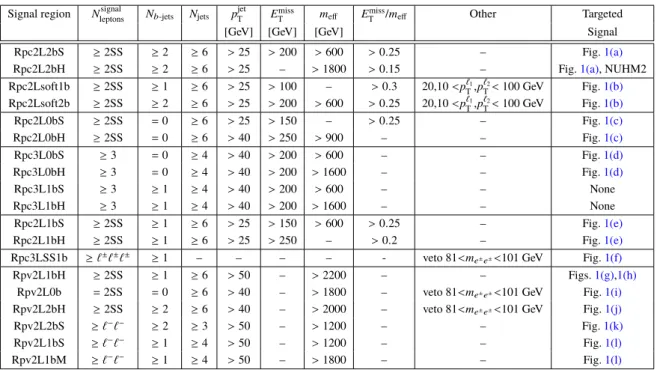
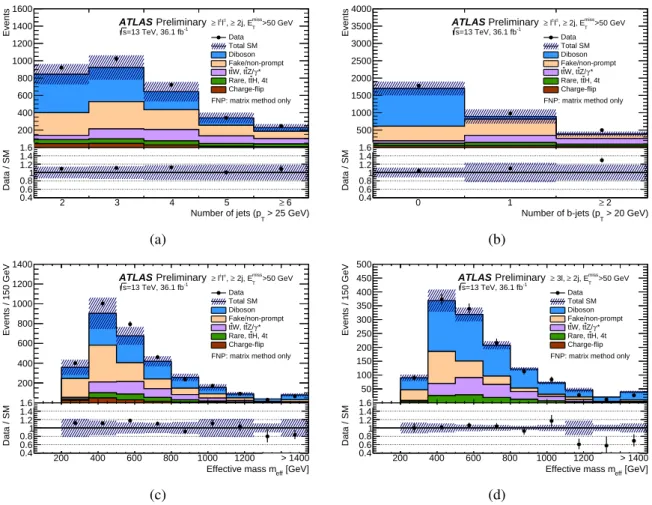
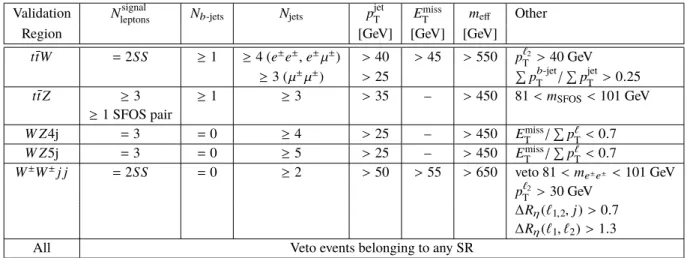
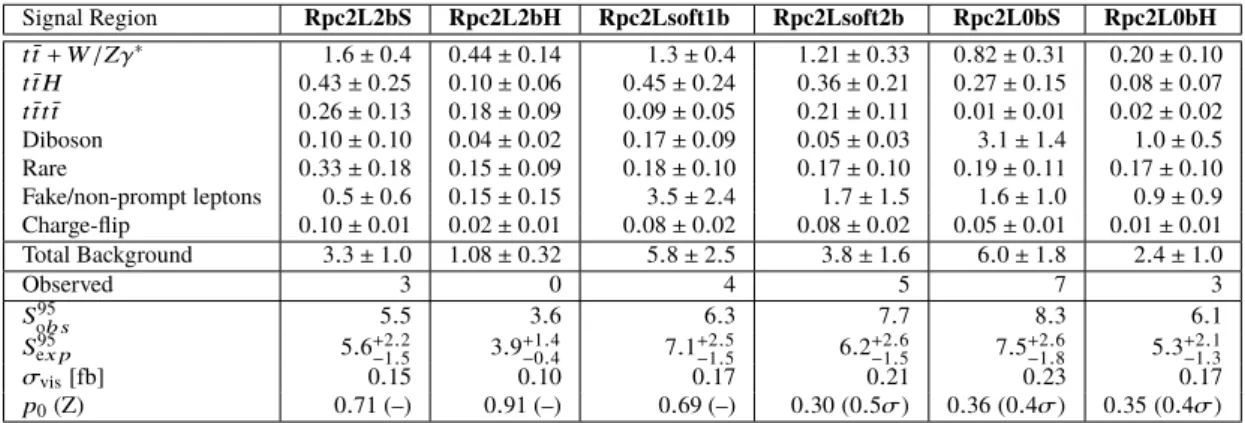
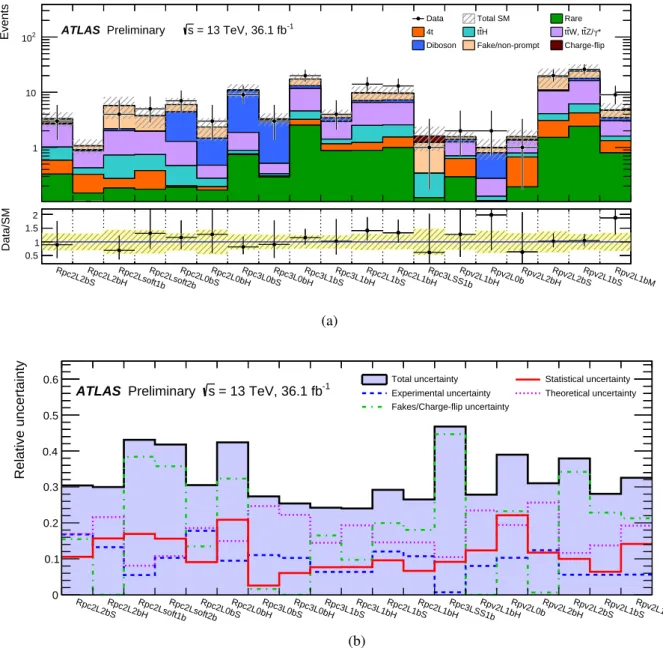
![Figure 6: Observed and expected exclusion limits as a function of m 1 / 2 for the NUHM2 model [31, 32]](https://thumb-eu.123doks.com/thumbv2/1library_info/4005639.1540827/19.892.248.680.345.783/figure-observed-expected-exclusion-limits-function-nuhm-model.webp)